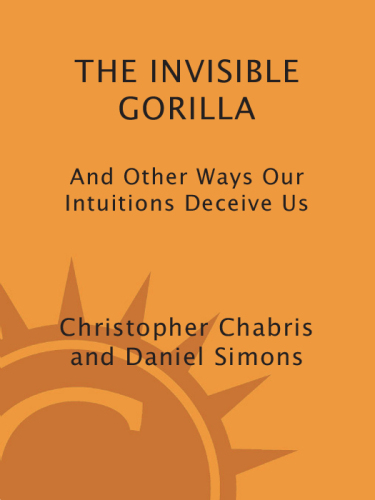
The Invisible Gorilla
And Other Ways Our Intuitions Deceive Us
کتاب های مرتبط
- اطلاعات
- نقد و بررسی
- دیدگاه کاربران
نقد و بررسی

July 5, 2010
Professors of Psychology Chabris and Simons write about six everyday illusions of perception and thought, including the beliefs that: we pay attention more than we do, our memories are more detailed than they are, confident people are competent people, we know more than we actually do, and our brains have reserves of power that are easy to unlock. Through a host of studies, anecdotes, and logic, the authors debunk conventional wisdom about the workings of the mind and what "experts" really know (or don't). Presented almost as a response to Malcolm Gladwell's blink, the books pay special attention to "the illusion of knowledge" and the danger of basing decision-making, in areas such as investing, on short-term information; in the authors' view, careful analysis of assumed truths is preferred over quick, intuitive thinking. Chabris and Simons are not against intuition, "...but we don't think it should be exalted above analysis without good evidence that it is truly superior."

March 1, 2010
A fascinating look at little-known illusions that greatly affect our dailylives. Chabris (Psychology/Union Coll. ) and Simons (Psychology/Univ. of Illinois) won a 2004 Ig Nobel Prize for their widely reported"gorilla experiment," which showed that when people focus on one thing, it's easy to overlook other things—even a woman in a gorilla suit. In their debut, they explore this habit of"inattentional blindness" and other common ways in which we distort our perception of reality. Their readable book offers surprising insights into just how clueless we are about how our minds work and how we experience the world. We think we see, know, remember or have the capacity to do something, when we actually do not. Recounting recent research and real-life examples, the authors focus on six illusions that make us overestimate our mental abilities. The illusion of attention allows us to look right at something and not consciously see it, as in the case of a gorilla appearing on court during a basketball game. The illusion of memory makes us believe we recall events precisely, when in fact we may embellish personal recollections of emotional moments like 9/11, and may even unintentionally plagiarize, thinking an idea is our own. Similarly, we hoodwink ourselves into overestimating our abilities (with the least skilled most likely to think better of themselves) and into believing we know more about the world than is justified (such as the time and expense involved in a planned project). The illusion of cause allows us to find the patterns in randomness that account for conspiracy theories and the discovery of religious images in sandwiches. Finally, we think we have enormous untapped mental ability that can be released with simple techniques, such as listening to the music of Mozart (the illusion of potential). The authors suggest that these illusions"might be so persistent and pervasive in our thought patterns precisely because they lead us to think better of ourselves than we objectively should." Be aware of these habits of mind, they write, and you can avoid being misled. Bound to have wide popular appeal.
(COPYRIGHT (2010) KIRKUS REVIEWS/NIELSEN BUSINESS M EDIA, INC. ALL RIGHTS RESERVED.)

April 15, 2010
Through a backdrop of amusing anecdotes and accounts of psychological experiments, Chabris and Simonspsychology professors and winners of the 2004 Nobel Prize in Psychologypaint a surprising picture of the everyday illusions that cause shifts in our sense of reality. The authors begin with an explanation of their famous "gorilla experiment," in which half the people asked to count passes among basketball players in a video missed the gorilla that appeared on the screen (available at http: //viscog.beckman.illinois.edu/flashmovie/15.php), to illustrate our inability to notice obvious details. They then move on to shatter many preconceived notions regarding attention, memory, confidence, knowledge, cause, and potential. These false notions have an impact on decisions made in everyday life and can determine whether or not a witness is credible, a consumer informed, or a physician trusted. The authors simultaneously engage readers and authenticate their claims by providing mini-experiments in which readers can participate. VERDICT Full of humor and insight, this book is enlightening and entertaining. Highly recommended for psychology students and others wishing to establish a more realistic picture of their intuition. Readers beware: your perception of everyday occurrences will be forever altered.Melissa Mallon, Univ. of Pittsburgh Johnstown, PA
Copyright 2010 Library Journal, LLC Used with permission.

June 1, 2010
Since psychologists Chabris and Simons first teamed up in the late 1990s for a study on perception, the so-called invisible-gorilla video buttressing their experiment has become world famous. In the clip, two teams pass a basketball around while a gorilla-suited woman briefly appears and pounds her chest before walking away. When viewers are instructed to count only the basketball passes, 50 percent completely miss seeing the gorilla. Even more surprising, however, is most peoples insistence that they could never miss something so glaringly obvious. This overconfidence in perceptual accuracy serves as the springboard for Chabris and Simons engaging treatise on how our intuitions often lead us astray. In chapters with titles like I Think I Would Have Seen That and Jumping to Conclusions, they methodically deconstruct what they refer to as our everyday illusions. Other forms of self-deception include faulty memories and misconstruing cause and effect, both illustrated with eye-opening, often humorous examples. Chabris and Simons gratifyingly supplement such ego-deflating illustrations with ways to better use the mind and ultimately protect ourselves from wrongdoers.(Reprinted with permission of Booklist, copyright 2010, American Library Association.)

























دیدگاه کاربران